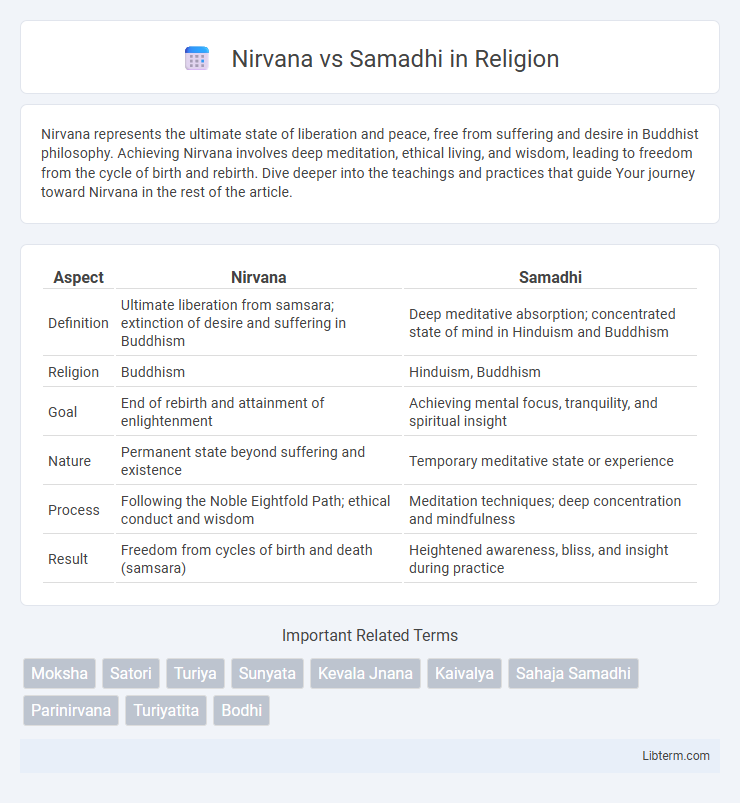Nirvana represents the ultimate state of liberation and peace, free from suffering and desire in Buddhist philosophy. Achieving Nirvana involves deep meditation, ethical living, and wisdom, leading to freedom from the cycle of birth and rebirth. Dive deeper into the teachings and practices that guide Your journey toward Nirvana in the rest of the article.
Table of Comparison
| Aspect | Nirvana | Samadhi |
|---|---|---|
| Definition | Ultimate liberation from samsara; extinction of desire and suffering in Buddhism | Deep meditative absorption; concentrated state of mind in Hinduism and Buddhism |
| Religion | Buddhism | Hinduism, Buddhism |
| Goal | End of rebirth and attainment of enlightenment | Achieving mental focus, tranquility, and spiritual insight |
| Nature | Permanent state beyond suffering and existence | Temporary meditative state or experience |
| Process | Following the Noble Eightfold Path; ethical conduct and wisdom | Meditation techniques; deep concentration and mindfulness |
| Result | Freedom from cycles of birth and death (samsara) | Heightened awareness, bliss, and insight during practice |
Understanding the Essence: What are Nirvana and Samadhi?
Nirvana represents the ultimate liberation from the cycle of birth, death, and rebirth, characterized by the extinguishing of desire, aversion, and ignorance, leading to profound inner peace and freedom from suffering. Samadhi refers to a deep state of meditative absorption or concentration where the mind becomes fully unified and calm, facilitating spiritual insight and mental clarity. While Samadhi is a temporary, experiential state achieved through meditation practices, Nirvana is the permanent realization of enlightenment and the cessation of all karmic conditioning.
Origins and Philosophical Roots
Nirvana, rooted in early Buddhist teachings, originates from the Pali word meaning "blowing out," symbolizing the extinguishing of desire, suffering, and the cycle of rebirth (samsara). Samadhi, central to Indian yoga and Hindu philosophies, denotes a state of intense concentration and meditative absorption, described extensively in Patanjali's Yoga Sutras. While Nirvana emphasizes liberation from samsara through the cessation of craving, Samadhi focuses on achieving a unified consciousness and mental stillness as a path to spiritual insight.
Core Differences in Definition
Nirvana refers to the ultimate liberation from the cycle of birth, death, and suffering in Buddhism, characterized by the extinguishing of desire and ignorance. Samadhi is a meditative state of intense concentration and mental absorption in Hinduism and Buddhism, serving as a means to achieve spiritual insight or enlightenment. While Nirvana denotes the final spiritual goal of freedom from samsara, Samadhi is a temporary, profound state of focused awareness that supports the path toward that liberation.
Pathways to Attainment
Nirvana is attained through the Eightfold Path, emphasizing ethical conduct, mental discipline, and wisdom to extinguish desire and suffering. Samadhi, often reached via concentrated meditation, cultivates deep states of mental absorption and tranquility essential for insight. Both pathways emphasize disciplined practice but differ as Nirvana represents liberation from suffering, while Samadhi signifies focused meditative attainment.
Relevance in Buddhism and Hinduism
Nirvana in Buddhism signifies the ultimate cessation of suffering and the cycle of rebirth, representing liberation through extinguishing desires and attachments. Samadhi in Hinduism denotes deep meditative absorption, a state of intense concentration that leads to spiritual awakening and unity with the divine. Both concepts emphasize transcendence but differ in their doctrinal interpretations and paths toward spiritual enlightenment.
States of Consciousness: Contrasts and Similarities
Nirvana and Samadhi represent distinct states of consciousness within Buddhist practice, where Nirvana signifies the ultimate liberation from suffering and the cycle of rebirth, characterized by the cessation of desire and attachment. Samadhi, on the other hand, is a deep meditative absorption leading to enhanced concentration and mental clarity, often viewed as a preparatory state toward achieving Nirvana. Both states involve profound transformation of consciousness but differ in their experiential qualities and spiritual goals--Samadhi serves as a focused, immersive experience, while Nirvana embodies a transcendent, permanent freedom from all conditioned existence.
Role of Meditation in Achieving Nirvana and Samadhi
Meditation serves as a crucial practice in achieving both Nirvana and Samadhi by cultivating deep concentration and insight into the nature of reality. In Nirvana, meditation helps extinguish the fires of desire, ignorance, and attachment, leading to liberation from the cycle of suffering and rebirth. In contrast, Samadhi represents a state of intense meditative absorption where the mind attains supreme tranquility and unity, forming the foundation for deeper spiritual realization and enlightenment.
Liberation and Enlightenment: Separate Destinations?
Nirvana and Samadhi represent distinct states within the path to spiritual liberation, with Nirvana signifying the ultimate release from the cycle of birth, death, and suffering, embodying complete enlightenment and freedom. Samadhi, often described as a deep meditative absorption, serves as a powerful tool or milestone facilitating the mind's focus and tranquility, but it is not the final liberation itself. Understanding these concepts as separate destinations clarifies that Samadhi is a means to achieve Nirvana, the permanent state of enlightenment and liberation in traditions such as Buddhism and Hinduism.
Misconceptions and Common Confusions
Nirvana and Samadhi are often confused due to their association with states of spiritual liberation, but Nirvana signifies the ultimate cessation of suffering and cycle of rebirth in Buddhism, whereas Samadhi refers to a deep meditative absorption or concentration. Misconceptions arise when Samadhi is mistakenly viewed as the final goal rather than a temporary, profound state aiding progress toward Nirvana. Understanding these distinctions clarifies that Samadhi is a meditative tool, while Nirvana represents the transcendental liberation beyond all mental states.
Modern Interpretations and Contemporary Significance
Modern interpretations of Nirvana emphasize its understanding as a psychological state of liberation from suffering, integrating ancient Buddhist principles with contemporary mindfulness practices. Samadhi is increasingly viewed not only as deep meditative concentration but also as a tool for enhancing cognitive clarity and emotional resilience in modern spirituality. Both concepts hold significant contemporary relevance, influencing fields like psychology, wellness, and cognitive science through their focus on mental peace and transformative awareness.
Nirvana Infographic

 libterm.com
libterm.com